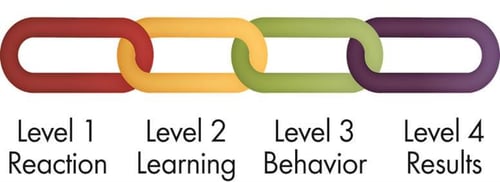The Kirkpatrick Model: An Old School Method to New School Learning
Kirkpatrick’s Model is a proven method to evaluate learning, and in our opinion, learning solutions too.
In 1954, Dr. Donald Kirkpatrick developed the Kirkpatrick Model in an effort to test if his training methods were positively impacting his learners and their success. His model is utilized for evaluating the effectiveness of training and considers the value of training, formal or informal, across four levels: Reaction, Learning, Behavior, and Results.

source: kirkpatrickpartners.com
Today, learning and development professionals are still faced with a similar issue of how to measure whether or not content is relevant, engaging, and effective in driving outcomes for today’s learners. However, even if it is determined that content is up to par, are L&D departments factoring in the importance of how this content is delivered and how that impacts the learner’s experience? That brings us to the question of which factors should be included when considering the effectiveness of a learning solution. Interestingly enough, as noted in LinkedIn's 2018 Workplace Learning Report, more than 500 L&D professionals identified proving ROI for learning solutions as one of their top challenges. While ROI is an important consideration, assessing a solution involves several other factors as well.
Using the Kirkpatrick Model to Assess Your Learning Solution
Let’s utilize this proven, simple, yet effective methodology to evaluate either your current learning solution or a prospective solution your organization might be exploring.
While it might seem logical to start with the first level of the model (Reaction), at BenchPrep, we believe starting with Results is a good way to define the problem you want to solve in order to determine the best solution.
Results: Define Your Learning Problem
Does your current learning solution meet your current business goals and objectives?
This is the step where you determine whether your learning program has had a positive effect on your organization. Think about your objectives and whether your learning content helped you achieve those goals. Your objectives could be anything from improving ROI, to increasing engagement rates, to reducing dropout rates - or all of the above!
A customizable platform should support the following capabilities:
- Meet the needs of all types of learners, course types, and learning goals (i.e. those studying for an exam, preparing to pass a required certification, training for a specific role, or just looking to expand on a skill to improve performance)
- Scale to meet the requirements of your current and future learner base
At this level, it’s always important keep in mind both your organizations’ and learners’ perspectives to achieve your goals. After taking a closer look at whether your learning program has provided you with the results you were looking for, you'll be able to define your organizations specific learning problem.
Behavior: Influencing Behavior Drives Results
Did your current learning solution influence learner behavior?
A solution should seamlessly guide a learner through necessary steps to ensure they are inclined to use the platform:
- Provide options for either a structured or personalized, adaptive learning pathway
- Allow a learner to leverage their strengths and weaknesses to help determine where they can best spend their time
After all, learners must be proactive in order to succeed. However, the more you can influence their behavior, the more likely they are to engage and see results.
Learning: Focus On The Learner Experience
Does your current learning program focus on the learner experience, or solely the management of content?
Offering an adaptive, engaging learning platform should help guide learners to:
- Consume bite-sized, accessible content, when and where they wish to consume it
- Assess their own confidence levels to reflect learning achievements and track tasks
Ensure the learning experience is helping to accelerate your current learning offerings. A blended learning model that includes in-person classes, webinars, virtual tools, etc., creates a well-rounded and cohesive learner experience.
Reaction: Assess Engagement
Does your current learning program engage your learners?
While it’s not always possible to gain real-time feedback about a particular program, an effective solution can measure engagement for the following:
- Activity levels of learners who contribute to the learner experience (i.e. discussion boards or forums)
- Voluntary use of engagement drivers, such as flashcards, games, and practice exams
- The Kirkpatrick Model is a perfect example of how old school methodology can be applied to new school learning techniques. This model can help you determine whether your learners are getting the learning experience they need and want.
Want to walk through these steps with us to evaluate if BenchPrep’s learner success platform is a good fit for your organization and its learning needs?






